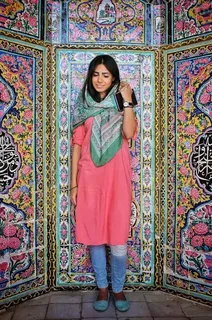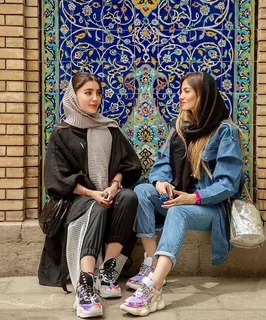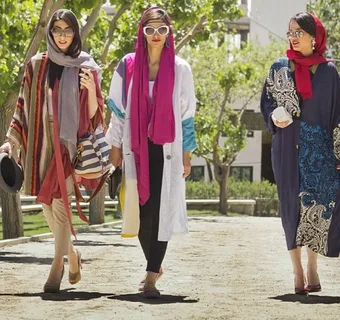Iranian women’s fashion is a fascinating blend of cultural tradition and modern innovation. From modest attire rooted in religious values to the subtle influence of Western trends, the fashion scene in Iran is a reflection of its rich history and evolving societal norms. For those curious about how fashion and culture intertwine in Iran, here’s an in-depth exploration of Iranian women’s fashion, its evolution, and its current state in the 21st century.
A Brief History of Iranian Women’s Fashion

The fashion landscape in Iran has always been closely linked to its political and cultural history. Prior to the Islamic Revolution in 1979, Iranian women’s fashion was heavily influenced by Western styles. Women wore short skirts, dresses, and followed global trends in beauty and fashion, often resembling the style seen in the West.
After the revolution, the new government enforced strict dress codes to align with Islamic values. Women were required to cover their hair and dress modestly in public, with loose-fitting clothing known as the chador or manteau, paired with a headscarf. This shift dramatically transformed Iranian women’s fashion from one of open Western influence to a more traditional, modest attire.
Modern-Day Fashion: Balancing Tradition and Style
Despite the mandatory dress code, Iranian women’s fashion has evolved in unique and creative ways. Today, many Iranian women blend modern fashion trends with the required modest attire. The manteau, a knee-length coat worn over clothes, is one of the most common outer garments for women. Designers have introduced modern cuts, colors, and patterns, offering a wide range of styles within the framework of modesty.
Many young women in urban areas, especially in cities like Tehran, push the boundaries of the dress code by incorporating contemporary elements. This includes pairing bright-colored headscarves with fitted manteaux and accessorizing with jewelry, belts, and bags that add a modern flair.
Iranian women often use fashion as a form of expression, navigating the delicate line between modesty and modernity. The emphasis on layers, unique prints, and attention to detail makes Iranian women’s fashion both distinctive and fashionable within the constraints of modest attire.
Influence of Global Trends
Global fashion trends have found their way into Iran, albeit with modifications to suit local customs. Social media, particularly Instagram, has become a platform for Iranian fashion influencers who showcase how to blend global trends with modest fashion. This has significantly impacted Iranian women’s fashion, allowing them to stay connected with the international fashion world while adhering to cultural and religious norms.
For instance, bohemian styles, oversized blazers, and wide-legged trousers have become popular, along with bold accessories. Iranian women’s fashion is increasingly influenced by the fashion scenes of neighboring countries like Turkey, as well as Western countries like France and Italy.
Colors and Fabrics in Iranian Women’s Fashion
Color plays a significant role in Iranian women’s fashion. While black is a common choice for the chador, urban women tend to favor brighter hues, particularly in their headscarves and manteaux. Earthy tones such as olive, burgundy, and navy blue are popular for daily wear, while bold colors like red, orange, and mustard yellow are seen in more stylish outfits.
Fabrics vary according to season and occasion. During the hot summer months, lightweight fabrics like cotton and linen are preferred for their breathability, while winter fashion incorporates heavier materials like wool and cashmere. Iranian women pay special attention to the texture and quality of fabrics, ensuring both comfort and style.
Challenges and Creativity in Iranian Fashion
Navigating the legal and social restrictions around fashion presents challenges for many Iranian women. Despite the dress code regulations, there is room for creativity. Women express their individuality through subtle choices in style, color, and accessories, making Iranian women’s fashion a creative response to cultural constraints.
Over time, local designers have carved a niche in the fashion industry, offering a variety of options that are both stylish and acceptable within the bounds of the law. This growing local fashion industry highlights the creativity and resilience of the Iranian fashion scene.
Accessories: Making a Statement
Accessories are a key element in Iranian women’s fashion. Since the clothing must be modest, women use jewelry, scarves, handbags, and even sunglasses to add flair to their outfits. Statement earrings, stacked bracelets, and colorful headscarves are commonly seen, helping women stand out while keeping their attire modest.
Handbags are often used as a statement piece, with brands like Louis Vuitton, Gucci, and Hermès being popular among those who can afford luxury items. On the other hand, more affordable local brands also offer trendy options that appeal to fashion-conscious women.
Iranian Fashion Designers: Shaping the Industry

A number of Iranian fashion designers have made significant contributions to the industry, both locally and internationally. Many designers have found innovative ways to combine traditional Persian elements with modern fashion. This fusion of old and new is key to the uniqueness of Iranian women’s fashion.
Designers like Naghmeh Kiumarsi and Anahita Mikdad are well-known for their work in Iran. These fashion icons have shown that Iranian women can look stylish and still adhere to societal expectations. Their designs incorporate Persian art, poetry, and history, offering a deep cultural connection through fashion.
FAQs
Q: Can women in Iran wear Western-style clothing?
A: Yes, but it must comply with Iran’s modest dress code. Western fashion trends are often modified to meet the legal requirements of covering the hair and wearing loose-fitting clothing.
Q: What is the most common clothing item in Iranian women’s fashion?
A: The manteau is one of the most common garments. It is a long coat or jacket worn over regular clothes, combined with a headscarf.
Q: How do Iranian women incorporate global trends into their fashion?
A: Iranian women creatively adapt global trends by selecting modest versions of popular styles, pairing Western accessories with their traditional attire, and following influencers on social media who blend modern fashion with local customs.
Conclusion
Iranian women’s fashion is a powerful example of how fashion can be both an expression of individuality and a reflection of cultural and societal values. Despite the challenges posed by legal dress codes, Iranian women continue to push the boundaries of fashion with creativity and grace. Their ability to merge tradition with contemporary trends demonstrates the resilience and innovation of women in Iran’s ever-evolving fashion scene.
This intricate blend of modesty, style, and cultural pride makes Iranian women’s fashion a unique and fascinating aspect of global fashion that continues to inspire women around the world.
Read more: womenfashionwear.site

